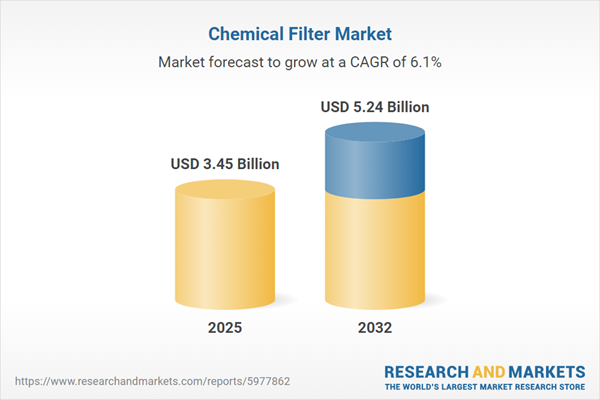Speak directly to the analyst to clarify any post sales queries you may have.
The chemical filter market is evolving steadily, shaped by regulatory demands, advances in filtration materials, and a growing imperative for sustainable industrial practices. This report delivers executive-level insights and actionable recommendations for leaders navigating an increasingly complex market landscape.
Market Snapshot: Chemical Filter Market Size and Growth Trajectory
The chemical filter market grew from USD 3.26 billion in 2024 to USD 3.45 billion in 2025. It is expected to continue growing at a CAGR of 6.11%, reaching USD 5.24 billion by 2032.
Chemical Filter Market Scope & Segmentation
This report covers comprehensive segmentation and global trends shaping the chemical filter sector. Key areas analyzed include:
- Material Types: Activated Carbon (granular, pellet, powdered), Ion Exchange Resin (anion, cation, mixed bed), Molecular Sieve (Type 3Å, 4Å, 5Å), Zeolite (natural, synthetic)
- End User Industries: Chemical Processing (bulk chemicals, petrochemicals, specialty chemicals), Food & Beverage, Oil & Gas, Pharmaceutical (API manufacturing, formulation), Water Treatment (industrial, municipal, residential)
- Applications: Dechlorination, Gas Purification (CO2 removal, H2S removal, VOC control), Heavy Metal Removal, Odor Removal, Solvent Recovery
- Regeneration Types: Non-Regenerable, Regenerable
- Product Forms: Portable, Stationary
- Distribution Channels: Aftermarket, OEM, Offline, Online
- Geographical Coverage: Americas (North America, Latin America), Europe, Middle East & Africa, Asia-Pacific
- Leading Companies Analyzed: Veolia Environnement S.A., SUEZ S.A., Evoqua Water Technologies Corp., The 3M Company, Kuraray Co., Ltd., Calgon Carbon Corporation, LANXESS AG, Purolite Corporation, Toray Industries, Inc., Pentair plc
Key Takeaways for Senior Decision-Makers
- The market is being shaped by stricter environmental regulations across continents, compelling end users to seek high-performance filtration technologies that can meet compliance and sustainability benchmarks.
- Emerging materials and digital integration have enabled more precise contaminant removal and real-time monitoring, improving cost efficiency and operational reliability.
- Modular and portable filtration solutions offer rapid deployment and address growth in decentralized water treatment and industrial operations, expanding market opportunities.
- Chemical filter manufacturers are strengthening supply chains by expanding local production facilities and forging long-term partnerships to navigate shifting tariff landscapes and reduce risk.
- Sustainability-focused end users increasingly favor regenerable media and circular economy-compatible solutions, influencing product innovation and lifecycle service models.
Assessing Tariff Impacts: US Policy and Supply Chain Implications
Recent tariff changes in the United States have increased costs for raw materials such as carbon precursors and resins, impacting filter media producers and prompting supply chain realignment. Manufacturers are mitigating risks through regional capacity expansion, supply agreements, and backward integration, while innovation is increasingly focused on raw material efficiency to offset input cost volatility. End users and suppliers are also revisiting contracts and pricing models to better share tariff-related risks and maintain procurement transparency.
Chemical Filter Market Research Methodology & Data Sources
Our in-depth market evaluation uses a dual approach, integrating extensive primary interviews with senior executives, technical experts, and procurement managers alongside systematic secondary research from academic journals, industry white papers, and regulatory filings. This methodology ensures the analysis is grounded in both current market realities and validated trends.
Why This Report Matters: Delivering Decision-Ready Value
- Unpacks critical market drivers, including regulatory, technological, and supply chain shifts, equipping leaders to act with confidence.
- Provides granular segmentation and actionable recommendations tailored to region, industry, and application—and highlights opportunities to optimize competitive positioning.
- Enables precise strategic planning and investment by delivering an integrated perspective on innovation, risk, and emerging end-user requirements.
Conclusion
Strategic adaptation to evolving technology, regulation, and regional contexts is essential to long-term success in the chemical filter market. Use these insights to prioritize innovation, fortify supply chains, and align with sustainable growth directives in a dynamic environment.
Additional Product Information:
- Purchase of this report includes 1 year online access with quarterly updates.
- This report can be updated on request. Please contact our Customer Experience team using the Ask a Question widget on our website.
Table of Contents
3. Executive Summary
4. Market Overview
7. Cumulative Impact of Artificial Intelligence 2025
Companies Mentioned
The companies profiled in this Chemical Filter market report include:- Veolia Environnement S.A.
- SUEZ S.A.
- Evoqua Water Technologies Corp.
- The 3M Company
- Kuraray Co., Ltd.
- Calgon Carbon Corporation
- LANXESS AG
- Purolite Corporation
- Toray Industries, Inc.
- Pentair plc
Table Information
| Report Attribute | Details |
|---|---|
| No. of Pages | 182 |
| Published | October 2025 |
| Forecast Period | 2025 - 2032 |
| Estimated Market Value ( USD | $ 3.45 Billion |
| Forecasted Market Value ( USD | $ 5.24 Billion |
| Compound Annual Growth Rate | 6.1% |
| Regions Covered | Global |
| No. of Companies Mentioned | 11 |









